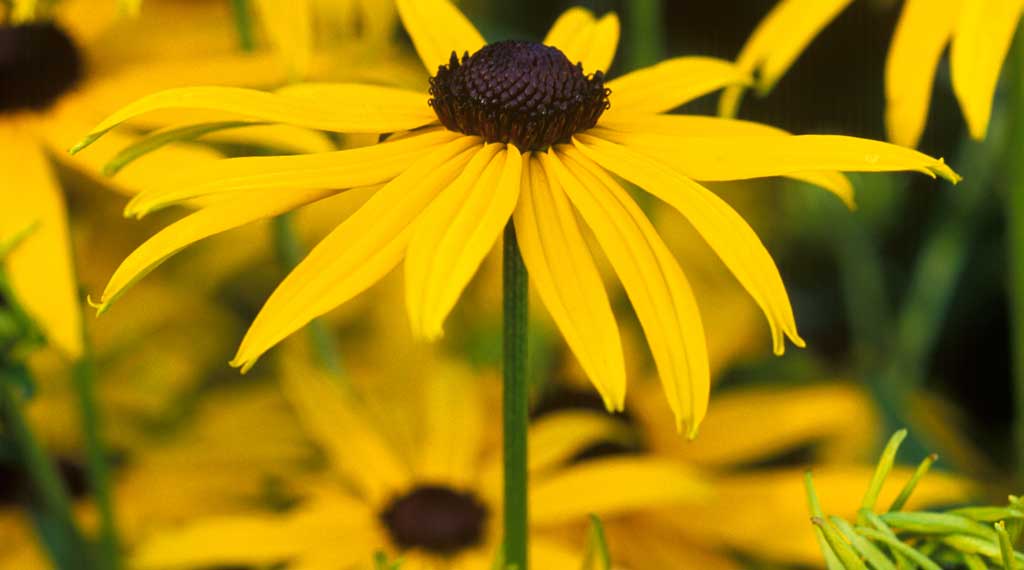
Rudbeckia ‘Goldsturm’
(Coneflower, perennial black-eyed susan)
This North American native, selected and named in Germany, has deservedly become one of the most popular and reliable of perennials. Among the rudbeckias, all native to North America, are some of the showiest perennials and annuals for late summer colour. The perennial species grow from 30 cm (1 ft.) in height to over 2 m (6 ft.) and most are reliable and easily grown plants to brighten up the garden in late summer and autumn. R. f. var. s. ‘Goldsturm’ is a cumbersome name, and it seems ironic that such a popular North American native was selected in what was then Czechoslovakia and named in Germany for its compact free flowering habit, eventually to return as a hero to its native land. Young nurseryman Heinz Hagemann took the plant to his famous employer Karl Foerster in Potsdam, Berlin, who gave it the name ‘Goldsturm’ (‘Gold Storm’) and introduced it around 1938. The original plant, it is said, was only about 45 cm (1½ ft.) high, but since it is often grown from seed, it has varied and can in moist soils reach 75–90 cm (2½–3 ft.). It makes leafy clumps of lance-shaped, dark glossy green leaves, above which a mass of deep-yellow-petalled flowers with central black cones make a striking contrast. R. f. var. s. ‘Goldsturm’ is the most compact of the species R. fulgida var. sullivantii, which has other subspecies, all native to eastern North America from New York south to Florida, and west to Ohio, Missouri and Texas, growing in open areas, moist meadows and valleys and on river banks.
R.f. var. s. ‘Goldsturm’ is an adaptable plant, growing in most soils where not too dry and excellent in moister soils, preferring full sun. By mid autumn when flowering has finished, black seedheads remain for the birds and are attractive in frost. Seeding can occur but is seldom a problem; if so, cut when flowering has finished. The spreading mats of roots and foliage may need curbing and occasional dieback of congested woody roots on older plants may ask for some replanting every few years, this best done in spring just as new growth appears. 60–75 cm (2–2½ ft.) × 45–60 cm (1½–2 ft.), spreading: F late summer, early autumn Z 3–9.
Further Recommendations
Other variations are equally valuable.
R. f. Viette’s Little Suzy ‘Blovi’ is a true dwarf, found as a seedling on Viette’s nursery in Virginia, small in leaf and flower and only 30 cm (1 ft.) high, with yellow petals and a black cone. R. f. var. deamii has hairy, lighter green leaves. Flowering well into autumn, it is taller at 90–120 cm (3–4ft.), and vigorous. So useful is its long-lasting display and general ease of culture that I’m happy to recommend R. laciniata ‘Goldquelle’ as an easy but underused late-flowering perennial with fully double golden-yellow flowers among bright green divided foliage, 120 cm (4 ft.) × 60 cm (2 ft.) high. Much taller and inclined to flop, so sometimes in need of staking, is the wonderful late-summer- and autumn-flowering R. l. ‘Herbstsonne’ (‘Autumn Sun’), with its warm yellow pendulous petals and chocolate-brown cigar stub cone. It provides autumn cheer with Eupatorium maculatum ‘Gateway’, and flowers until frosts. If too tall, cut back in late May or early June by half to reduce eventual height, although the sight of flowers against a blue autumn sky is one of this plant’s delights. 180–240 cm (6–8 ft.) × 90–120 cm (3–4 ft.), F late summer to late autumn. Z 3–9.

